 "ttyymmnn" (ttyymmnn)
"ttyymmnn" (ttyymmnn)
07/03/2018 at 12:35 • Filed to: wingspan, Planelopnik, TDIAH
 13
13
 15
15
 "ttyymmnn" (ttyymmnn)
"ttyymmnn" (ttyymmnn)
07/03/2018 at 12:35 • Filed to: wingspan, Planelopnik, TDIAH |  13 13
|  15 15 |
!!! UNKNOWN CONTENT TYPE !!!
Welcome to
This Date in Aviation History
, getting of you caught up on milestones, important historical events and people in aviation from June 30 through July 3.
!!! UNKNOWN CONTENT TYPE !!!
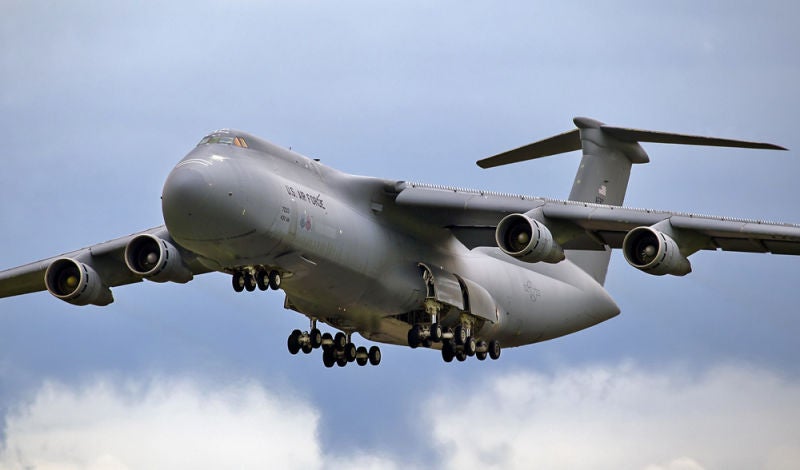 !!!CAPTION ERROR: MAY BE MULTI-LINE OR CONTAIN LINK!!!
!!!CAPTION ERROR: MAY BE MULTI-LINE OR CONTAIN LINK!!!
June 30, 1968 – The first flight of the Lockheed C-5 Galaxy. It’s unclear as to whether it was !!!error: Indecipherable SUB-paragraph formatting!!! or !!!error: Indecipherable SUB-paragraph formatting!!! who made the famous observation on the logistics of warfare that “An army travels on its stomach,” though it is a truism that lasted from the earliest days of war into our modern jet age. However, an army doesn’t only need beans; it needs bullets, all manner of materiel, and it also needs to get soldiers to the battle. Fought in two theaters on opposite sides of the planet, WWII demonstrated the need for truly global logistics and, following the war, the US Air Force joined the age of strategic jet transport when the !!!error: Indecipherable SUB-paragraph formatting!!! entered service in 1965. But no sooner had that remarkable aircraft made its first flight than the Air Force began looking for something even bigger, and ended up with what was at the time one of the largest aircraft in the world.
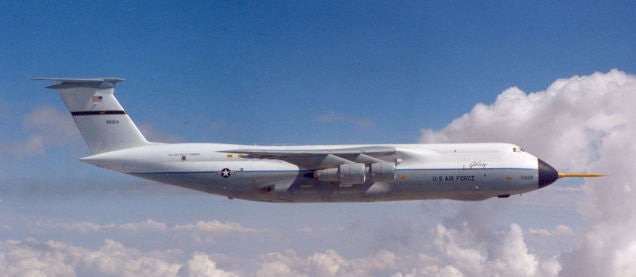
The second C-5 to be built undergoing a test flight in California in 1969 (US Air Force)
Work on a large strategic heavy-lifter began in 1961 when manufacturers took part in a program to develop an aircraft that would serve as both a replacement for the !!!error: Indecipherable SUB-paragraph formatting!!! turboprop cargo aircraft and as a complement to the smaller C-141. The Air Force needed something that could carry larger vehicles and equipment, have a maximum takeoff weight (MOT) of 600,000 pounds, and could still operate from the same runways used by the Starlifter. That requirement was then amended to an aircraft that could deliver a payload of 125,000 pounds at a distance of 8,000 miles, essentially doubling the payload for half the distance of the original requirement. Boeing, Douglas and Lockheed all submitted proposals in 1964, and General Electric began work to develop an engine that was capable of moving a plane with a 700,000 pound MOT. Though Boeing’s design was deemed better than Lockheed’s, Lockheed won the contract, in large part because they were the lower bidder. The Air Force awarded a production contract to Lockheed in 1965, and the !!!error: Indecipherable SUB-paragraph formatting!!! high-bypass turbofan was chosen at the same time.
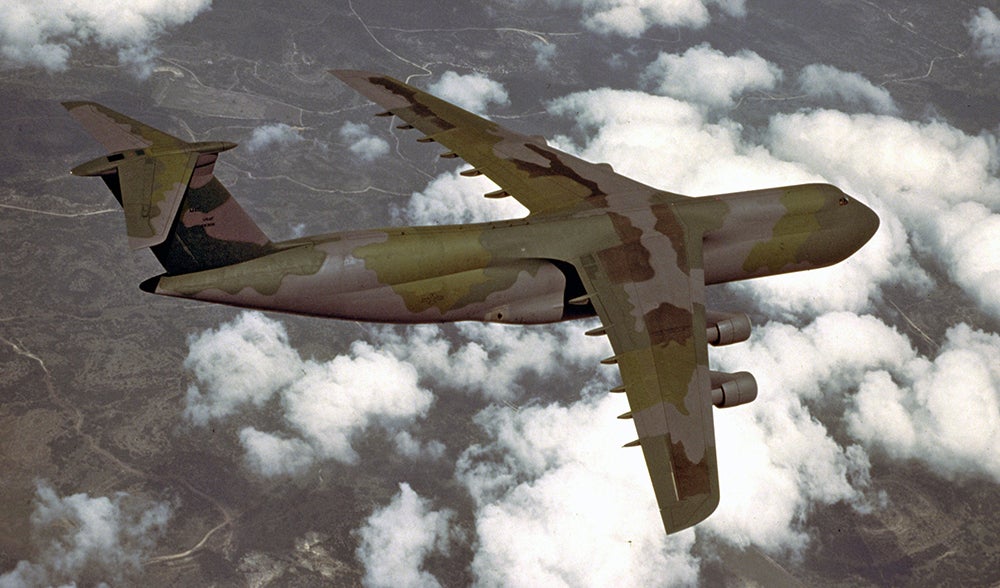
A Lockheed C-5A Galaxy in “Europe 1" camouflage circa 1980. Originally, all C-5s were painted white over grey. (US Air Force)
Following its maiden flight, the first production aircraft were delivered in December 1969, and 81 C-5As were delivered by the end of 1973. The new heavy lifter immediately showed its mettle by carrying personnel and materiel to Europe and Southeast Asia, and provided logistical support in the waning years of the Vietnam War. The Galaxy played a major role in transporting soldiers and materiel during the Gulf War, and it continues to support operations in Afghanistan and Iraq. The C-5 is also the largest aircraft to fly to the Antarctic. It’s low cargo deck, with doors in both front and back, allows drive-through loading, and its wide girth meant that the Military Airlift Command could now transport any vehicle in the US inventory and twice as much payload as the C-141. The Galaxy can accommodate two !!!error: Indecipherable SUB-paragraph formatting!!! main battle tanks plus two !!!error: Indecipherable SUB-paragraph formatting!!! , or up to six !!!error: Indecipherable SUB-paragraph formatting!!! attack helicopters. The main deck can transport up to 270 troops.
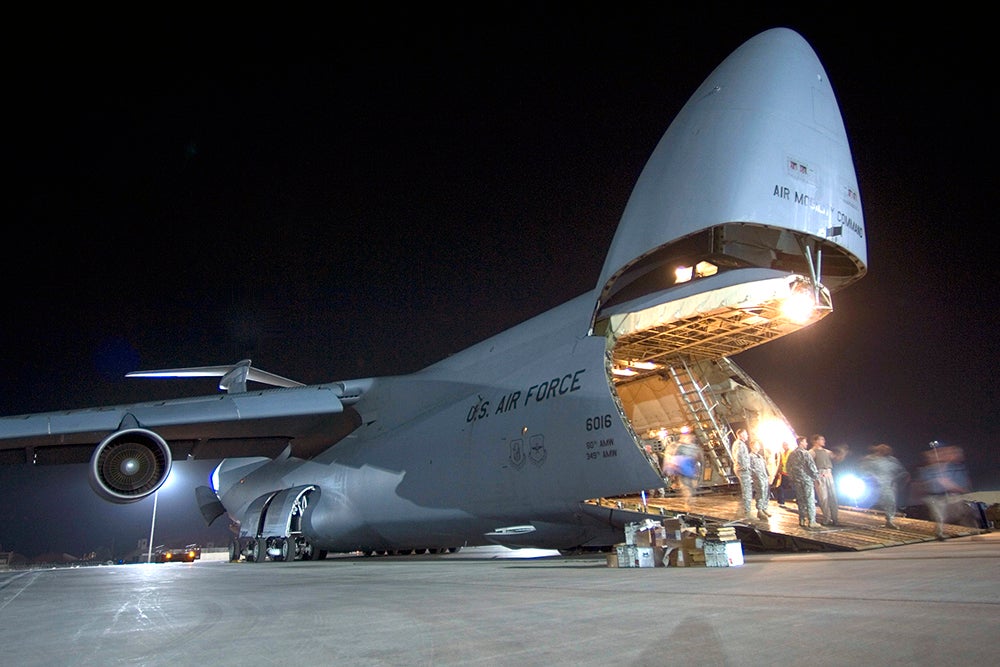
With the nose of the aircraft raised above the flight deck and rear clamshell doors open, airmen of the US Air Force unload a Lockheed C-5 Galaxy at the Balad Air Base in Iraq in 2008 (US Air Force)
The Galaxy has proven to be a cargo workhorse, but all that heavy lifting meant that the wings needed replacing by the 1980s to extend their service life, and the C-5 AMP program will refit existing aircraft with modern avionics, and Reliability Enhancement and Re-engining Program (RERP) will fit new !!!error: Indecipherable SUB-paragraph formatting!!! turbofans and make other upgrades to the airframe. These new aircraft are dubbed the C-5M Super Galaxy, and these updated aircraft are expected to serve until at least 2040.
!!! UNKNOWN CONTENT TYPE !!!
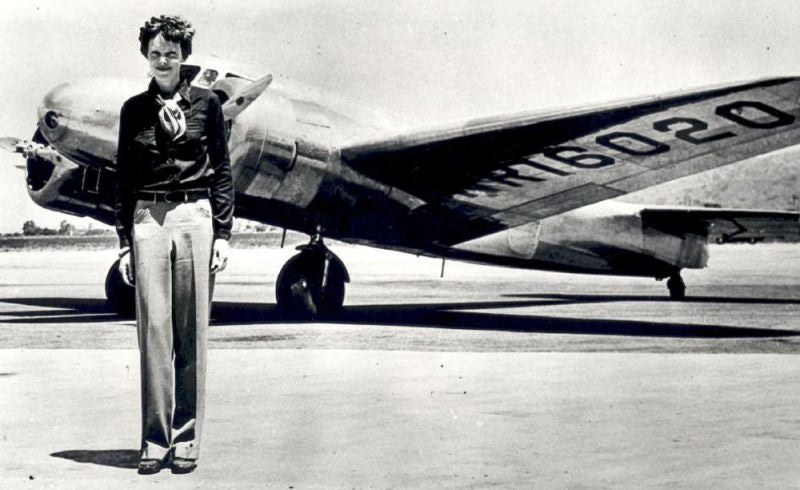
(NASA)
July 2, 1937 – Amelia Earhart and navigator Fred Noonan disappear over the Pacific Ocean while attempting to circumnavigate the globe.
The history of aviation has had many important contributors, but for the most part, those contributions were made by men. Not because men were more capable of building or flying aircraft, but simply because society didn’t believe that flying was an appropriate endeavor for women. The Wright Brothers refused to train female pilots, and the British aviation pioneer
!!!error: Indecipherable SUB-paragraph formatting!!!
went so far as to say, “...women lack qualities which make for safety in aviation. They are temperamentally unfit for the sport.” The fact that Grahame-White saw flying as a sport is telling, but he was not alone in his views. Still, many women fought for their rightful place in the field, and those pioneering aviatrixes gained notoriety and broke barriers that helped create opportunities for those who followed.
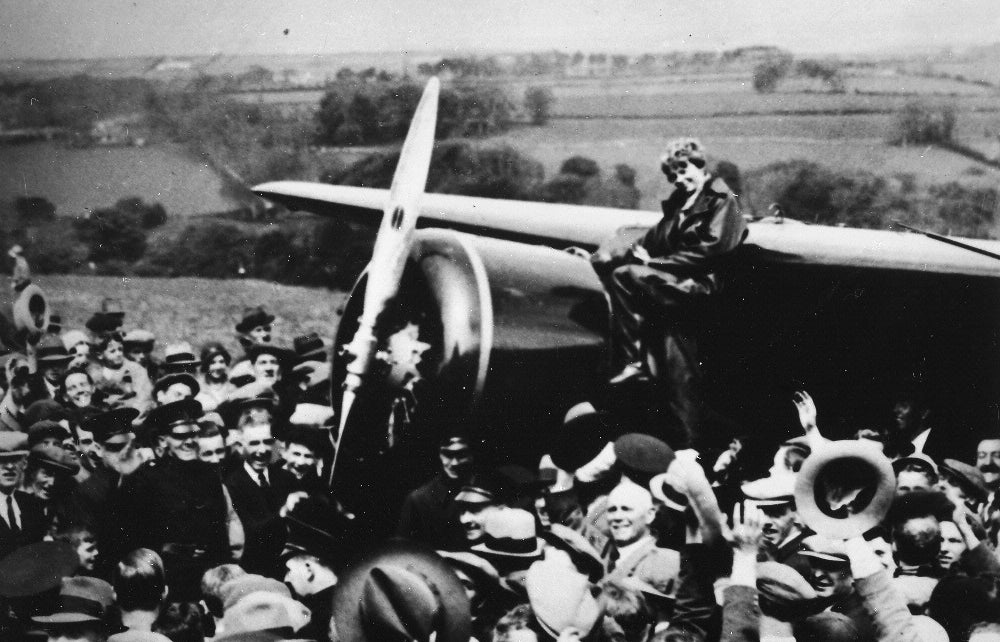
Amelia Earhart, standing on her Lockheed Vega 5B, receives the adulations of the crowd in Ireland following her solo flight across the Atlantic Ocean. (National Air and Space Museum)
Amelia Earhart was smitten with aviation at a young age, and took her first flying lessons in 1921. Soon after, she purchased her first airplane, a !!!error: Indecipherable SUB-paragraph formatting!!! biplane that she named The Canary . She became a celebrity in 1928 as the first woman to fly across the Atlantic Ocean, though she was merely a passenger and did no piloting. On arriving in Wales, Earhart told a reporter, “...maybe someday I’ll try it alone.” She did just that in 1932, when she piloted a !!!error: Indecipherable SUB-paragraph formatting!!! from Newfoundland to Ireland and was awarded the !!!error: Indecipherable SUB-paragraph formatting!!! as the first woman to pilot a plane across the Atlantic. Earhart made subsequent solo flights and set numerous records, but she had her heart set on the greatest feat that had not yet been accomplished by a female pilot: the circumnavigation of the globe.
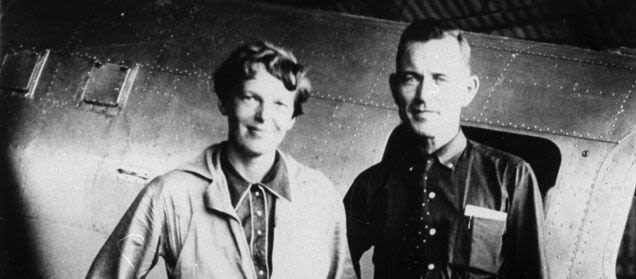
Earhart with navigator Fred Noonan on June 11, 1937. ( Topical Press Agency/Getty Images)
Earhart made her first attempt in March 1937 flying east to west, but that flight ended in Hawaii following engine trouble. For her second attempt, she teamed with experienced navigator !!!error: Indecipherable SUB-paragraph formatting!!! , and the pair began their west to east journey with an unpublicized flight from Oakland to Miami in Earhart’s !!!error: Indecipherable SUB-paragraph formatting!!! . Once in Miami, Earhart publicly announced her intention to fly around the world. On June 1, 1937, Earhart and Noonan departed from Miami and made stops in South America, Africa, India and Southeast Asia before arriving in Lae, New Guinea on June 29 after covering roughly 22,000 miles. The Pacific Ocean was their last big obstacle.
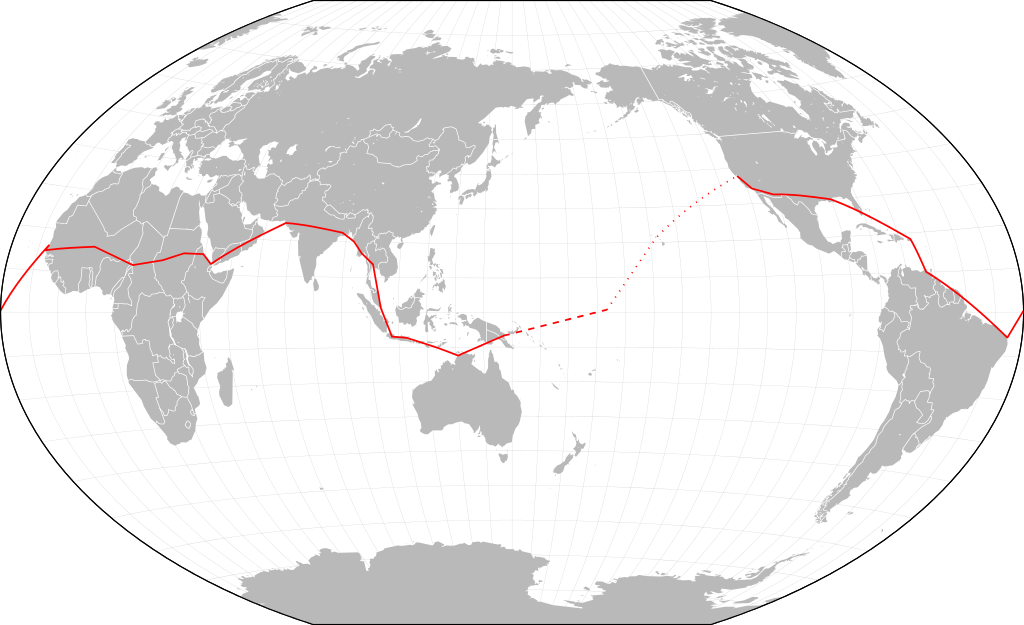 !!!CAPTION ERROR: MAY BE MULTI-LINE OR CONTAIN LINK!!!
!!!CAPTION ERROR: MAY BE MULTI-LINE OR CONTAIN LINK!!!
The pair departed from Lae on July 2 at midnight GMT and headed for !!!error: Indecipherable SUB-paragraph formatting!!! , a tiny speck of land 2,556 miles away. The Coast Guard cutter !!!error: Indecipherable SUB-paragraph formatting!!! was on station at Howland to guide them by radio for the final part of their flight. As they approached Howland, Earhart and Noonan made contact with Itasca , but problems with the radio set meant that the crew of Itasca could hear Earhart, but Earhart and Noonan could not hear Itasca. The ship sent out tracking signals, but the fact that Earhart didn’t home in on them indicates that there may have been a problem with the Electra’s direction finder as well. At one point, Earhart radioed, “We must be on you, but cannot see you—but gas is running low.” She requested that Itasca send voice signals so she could take a radio bearing, and the strength of the signal received by the cutter meant that her Electra was very close, yet could not be seen. Earhart’s final transmission indicated that they believed they were near Howland; however, they had likely missed it by as few as five miles. Unable to contact the plane by radio, Itasca sent up smoke signals from the ship’s boilers in hopes that they would be seen, but to no avail. After those few radio calls, Earhart and Noonan were never seen nor heard from again.
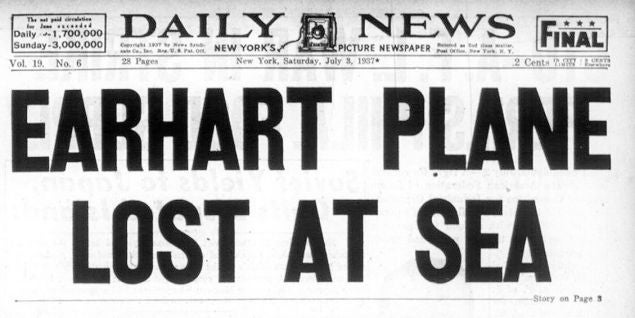
Search efforts lasted until July 19, and, despite the best efforts of the Coast Guard and Navy, no trace of the Earhart or Noonan, or the Electra, was ever found. Some believe that Earhart and Noonan simply ran out of fuel and came down in the Pacific. Another theory is that they landed at Gardner Island, now !!!error: Indecipherable SUB-paragraph formatting!!! , an uninhabited coral atoll in the Phoenix Islands, and were stranded there until they eventually died. Others have suggested that !!!error: Indecipherable SUB-paragraph formatting!!! places Earhart in the Marshall Islands, a prisoner of the Japanese Army, though those claims have largely been discredited. Searchers have also turned up evidence that they claim are parts of Earhart’s Electra, and even a skeleton and a shoe. But the evidence is circumstantial, and the mystery of their disappearance remains unsolved to this day. (Earhart Electra photo via NASA; Earhart and Noonan photo author unknown)
!!! UNKNOWN CONTENT TYPE !!!
Short Takeoff
!!! UNKNOWN CONTENT TYPE !!!
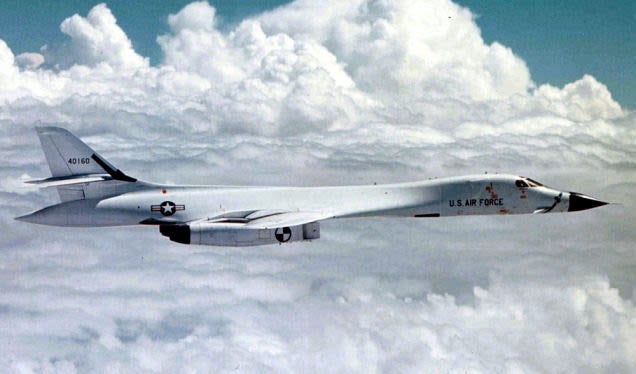
(US Air Force)
June 30, 1977 – President Jimmy Carter cancels the Rockwell B-1 Lancer.
Following the cancellation of the
!!!error: Indecipherable SUB-paragraph formatting!!!
program to develop a supersonic successor to the
!!!error: Indecipherable SUB-paragraph formatting!!!
, the process was restarted under the Nixon Administration and work on the new bomber recommenced. But with the arrival of the
!!!error: Indecipherable SUB-paragraph formatting!!!
, and its
!!!error: Indecipherable SUB-paragraph formatting!!!
successor with look-down shoot-down radar, the viability of the new bomber was put into question, and the program was canceled by the
!!!error: Indecipherable SUB-paragraph formatting!!!
in the face of spiraling budgets and the development of
!!!error: Indecipherable SUB-paragraph formatting!!!
. The program was subsequently restored by the
!!!error: Indecipherable SUB-paragraph formatting!!!
in 1981, with the development of the more advanced B-1B which first flew in 1974 and remains in service today.
!!! UNKNOWN CONTENT TYPE !!!
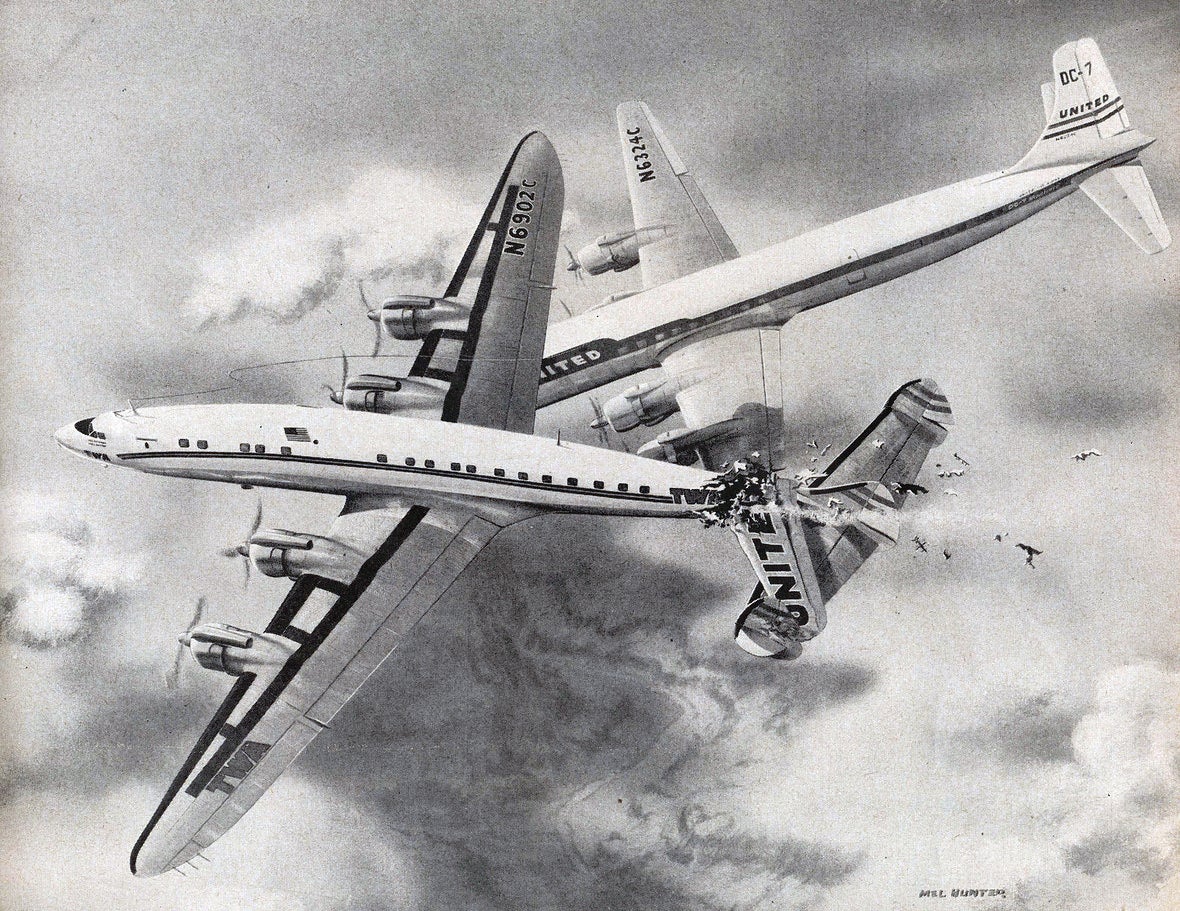
(LIFE Magazine)
June 30, 1956 – Two airliners collide in midair over the Grand Canyon.
At approximately 10:30 am, TWA Flight 2, a
!!!error: Indecipherable SUB-paragraph formatting!!!
en route from Los Angeles to Kansas City collided in midair with United Airlines Flight 718, a
!!!error: Indecipherable SUB-paragraph formatting!!!
flying from Los Angeles to Chicago. The wreckage rained down on a remote part of the Grand Canyon and resulted in the deaths of all 128 passengers and crew on both flights. Evidence indicates that at least one of the airliners spotted the other and initiated unsuccessful evasive maneuvers before the aircraft collided, and investigators indicated that the pilots likely did not see each other in time due to clouds, poor cockpit visibility, and high cockpit workload. The crash was the deadliest to date on US soil, and led to the creation of the Federal Aviation Agency (later the
!!!error: Indecipherable SUB-paragraph formatting!!!
) in 1958 to give the office total authority over American airspace, and also spurred the modernization of air traffic control.
!!! UNKNOWN CONTENT TYPE !!!
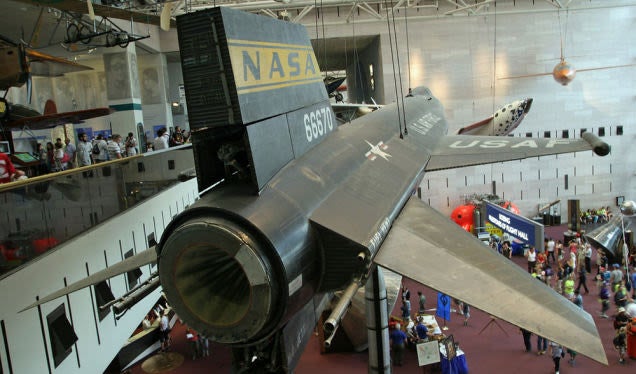
(Tim Shaffer)
July 1, 1976 – The National Air and Space Museum opens in Washington, DC. Part of the !!!error: Indecipherable SUB-paragraph formatting!!! , the NASM holds the largest collection of historic aircraft and spacecraft in the world and, with 7.4 million visitors in 2016, it is the 2nd most-visited museum in the world and the most visited museum in the US. The NASM was originally established in 1946 as the National Air Museum, and today it displays some of the most important aircraft in the history of aviation, including the !!!error: Indecipherable SUB-paragraph formatting!!! , the !!!error: Indecipherable SUB-paragraph formatting!!! , the !!!error: Indecipherable SUB-paragraph formatting!!! , and the !!!error: Indecipherable SUB-paragraph formatting!!! , as well as spacecraft such as the !!!error: Indecipherable SUB-paragraph formatting!!! capsule and the !!!error: Indecipherable SUB-paragraph formatting!!! . In addition to its collection in Washington, DC, the NASM operates the !!!error: Indecipherable SUB-paragraph formatting!!! in Maryland and the !!!error: Indecipherable SUB-paragraph formatting!!! near Dulles Airport that houses pieces of the museums’s vast collection that do not fit in the building on the Washington Mall.
!!! UNKNOWN CONTENT TYPE !!!
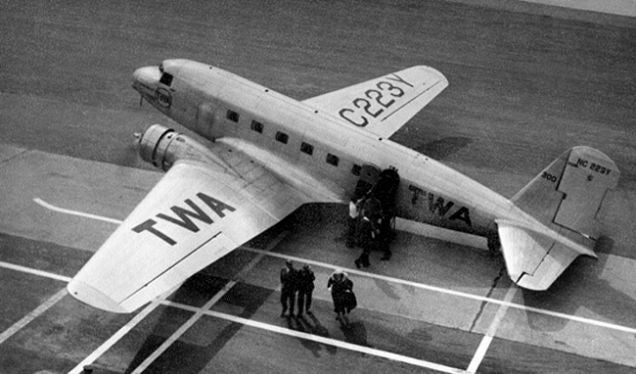
(San Diego Air and Space Museum)
July 1, 1933 – The first flight of the Douglas DC-1,
the first model of the DC (Douglas Commercial) airliner series that found its greatest success with the DC-3. Development of the DC-1 began in 1931 after the high-profile crash of a
!!!error: Indecipherable SUB-paragraph formatting!!!
trimotor that suffered a structural failure which was traced to its wooden wings. With Boeing selling its successful
!!!error: Indecipherable SUB-paragraph formatting!!!
exclusively to United Airlines, TWA approached Douglas to build an all-metal airliner for them. Though only one DC-1 was built, rigorous testing showed it to be significantly superior to the aircraft it was meant to replace, and it formed the basis for the improved
!!!error: Indecipherable SUB-paragraph formatting!!!
, which entered service with TWA in 1934 and saw nearly 200 built.
!!! UNKNOWN CONTENT TYPE !!!
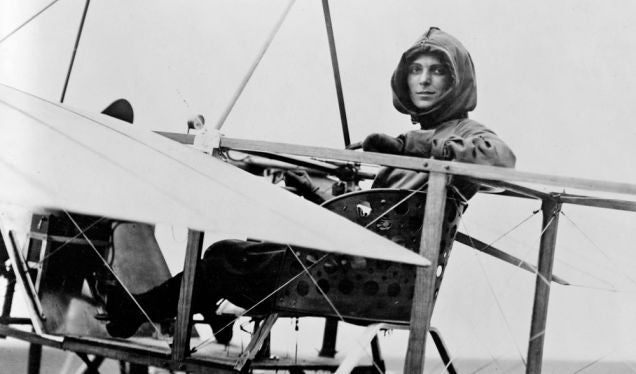
(US Library of Congress)
July 1, 1912 – The death of Harriet Quimby. Born on May 11, 1875, Quimby became the first woman to earn a pilot’s license in the United States in 1911, and her exploits were an inspiration to many women of her day who railed against male-dominated society. Quimby was hired as a spokesperson by the Vin Fiz Company, and became the first woman to fly across the English Channel in 1912, a feat that was unfortunately overshadowed by news of the sinking of the !!!error: Indecipherable SUB-paragraph formatting!!! just one day later. Quimby was killed during a flight when, for unknown reasons, her !!!error: Indecipherable SUB-paragraph formatting!!! monoplane suddenly pitched forward, ejecting both her and her passenger at an altitude of 1,500 feet. Ironically, the plane came to earth relatively undamaged.
!!! UNKNOWN CONTENT TYPE !!!
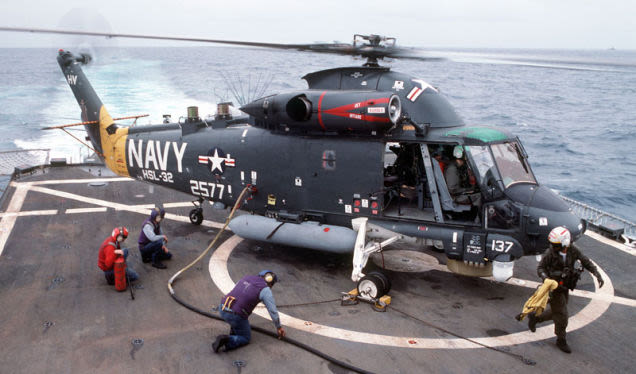
(US Navy)
July 2, 1959 – The first flight of the Kaman SH-2 Seasprite,
an all-weather, high-speed helicopter designed to fulfill the role of anti-submarine warfare, search and rescue, light cargo transport, and liaison. The single main rotor was a design departure for Kaman, which was best known for their dual, intermeshing rotor designs that eliminate the need for a tail rotor, and the original Seasprite was powered by a single
!!!error: Indecipherable SUB-paragraph formatting!!!
turboshaft engine with an anti-torque rotor at the tail. The Seasprite entered service in 1962, but was quickly found to be underpowered. In response, Kaman added a second turboshaft engine, with both engines housed in external pods. Nearly 200 Seasprites were produced, and they served primarily with the US Navy and the Royal New Zealand Air Force before being retired by the US Navy in 1993.
!!! UNKNOWN CONTENT TYPE !!!
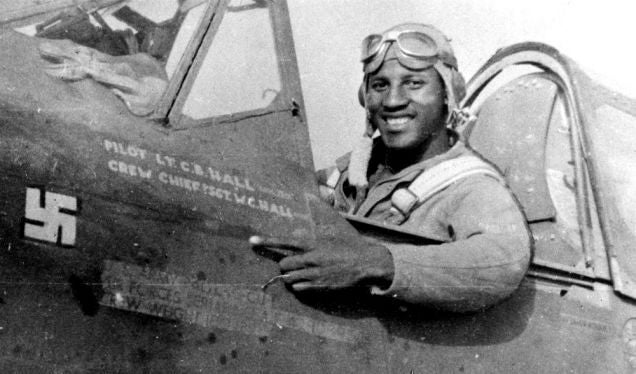
(Author unknown)
July 2, 1943 – Lt. Charles Hall becomes the first African-American pilot to shoot down a German plane.
A native of Brazil, Indiana, Hall flew with the
!!!error: Indecipherable SUB-paragraph formatting!!!
and was a member of the
!!!error: Indecipherable SUB-paragraph formatting!!!
. Following the deployment of his unit in support of the Allied invasion of Sicily in 1943, Hall’s squadron was tasked with escorting a flight of
!!!error: Indecipherable SUB-paragraph formatting!!!
bombers in an attack on Castelvetrano in southwestern Sicily. When the flight was attacked by
!!!error: Indecipherable SUB-paragraph formatting!!!
, Hall turned his
!!!error: Indecipherable SUB-paragraph formatting!!!
to intercept and downed one, the first of three victories he would score in service with the 99th. After returning to the US, Hall reached the rank of major in the US Air Force before his retirement in 1967. Hall died in 1971.
!!! UNKNOWN CONTENT TYPE !!!
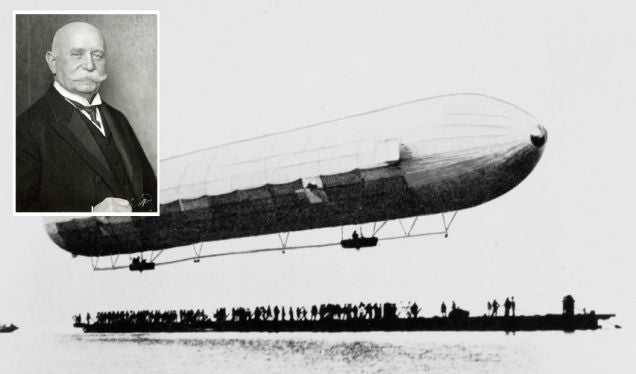
(Staatsbibliothek zu Berlin; US Library of Congress)
July 2, 1900 – Count Ferdinand von Zeppelin flies the first rigid airship. Count Zeppelin first expressed his ideas about building rigid airships in 1874, perhaps inspired by his time in the US observing the balloon camp of !!!error: Indecipherable SUB-paragraph formatting!!! during the Civil War. After a stint in the military, Zeppelin devoted all of his time to the development of a rigid airship, and he built and flew the first rigid airship, !!!error: Indecipherable SUB-paragraph formatting!!! , from a floating hangar on Lake Constance in southern Germany. Constructed using a cylindrical metal framework covered with cotton cloth and lifted by 17 gas cells made from rubberized cotton, the LZ 1 was small by later standards, and carried just five passengers. The first of three flights covered a distance of 3.7 miles in 17 minutes before a malfunction led to a forced landing. But Zeppelin started a revolution of airship design and, by 1914, his airships had transported over 37,000 passengers on over 1,600 flights without incident.
!!! UNKNOWN CONTENT TYPE !!!
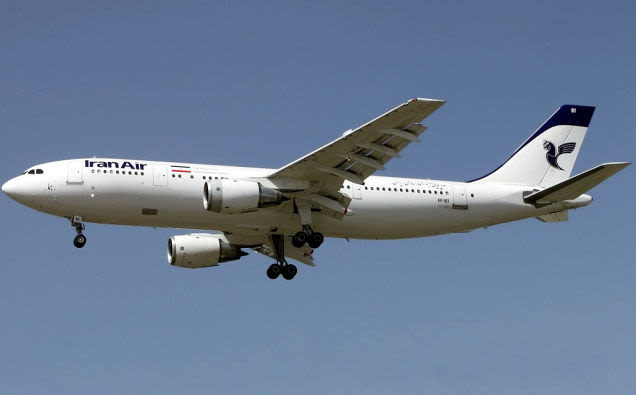 !!!CAPTION ERROR: MAY BE MULTI-LINE OR CONTAIN LINK!!!
!!!CAPTION ERROR: MAY BE MULTI-LINE OR CONTAIN LINK!!!
July 3, 1988 – The US Navy cruiser USS
Vincennes
shoots down Iran Air Flight 655 over the Persian Gulf.
While operating in the Persian Gulf to protect civilian shipping during the
!!!error: Indecipherable SUB-paragraph formatting!!!
, the US Navy
Ticonderoga
-class cruiser
!!!error: Indecipherable SUB-paragraph formatting!!!
!!!error: Indecipherable SUB-paragraph formatting!!!
(CG-49) detected an Iran Air
!!!error: Indecipherable SUB-paragraph formatting!!!
(EP-IBU) operating in Iranian territory on a scheduled route and issuing squawks that identified it as a civilian aircraft. Believing it instead to be an Iranian
!!!error: Indecipherable SUB-paragraph formatting!!!
on an attack mission,
Vincennes
shot down the airliner with two missiles, killing all 290 passengers and crew. The US never officially apologized for the incident, though it did formally express regret and paid $62 million dollars to the families of the victims. In 1989, a pipe bomb detonated in a van driven by the wife of Captain
!!!error: Indecipherable SUB-paragraph formatting!!!
, the commanding officer of
Vincennes
at the time of the attack, though no evidence was ever found to determine that the act was in retaliation for Iran Air incident. Rogers’ wife was unhurt.
!!! UNKNOWN CONTENT TYPE !!!
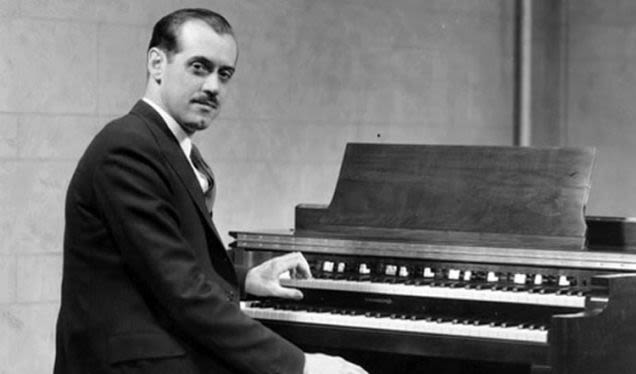
(Author unknown)
July 3, 1973 – The death of Laurens Hammond. Born on January 11, 1895, Hammond is best known for his invention of the !!!error: Indecipherable SUB-paragraph formatting!!! , the !!!error: Indecipherable SUB-paragraph formatting!!! , and the !!!error: Indecipherable SUB-paragraph formatting!!! , the world’s first !!!error: Indecipherable SUB-paragraph formatting!!! music synthesizer. Nevertheless, Hammond holds an important place in aviation history. Following service in WWI as an engineer, Hammond again served his country as an inventor during WWII by developing bomb and missile guidance systems. He was awarded patents for infrared and light-sensing bomb guidance systems, developed a new gyroscope that was less sensitive to the cold of high altitude, as well as controls for a gliding bomb, the forerunner of our modern guided missile.
!!! UNKNOWN CONTENT TYPE !!!
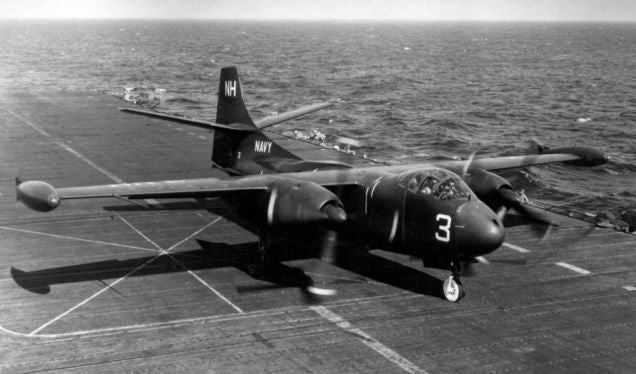
(US Navy)
July 3, 1948 – The first flight of the North American AJ (A-2) Savage, a large hybrid-powered nuclear bomber designed to operate from US Navy carriers. The Savage was the heaviest carrier aircraft ever put in service at the time, and was powered by two !!!error: Indecipherable SUB-paragraph formatting!!! radial engines in the wings and one !!!error: Indecipherable SUB-paragraph formatting!!! turbojet in the rear, though the turbojet was only intended for use during takeoff and high-speed attack runs. The Savage entered service in 1950, but it was cumbersome to operate onboard the carriers. The size of the aircraft hampered deck operations, and folding the wings one at a time by hydraulic pump was a slow process. The Savage also served as an aerial tanker and reconnaissance aircraft, and a few were pressed into aerial firefighting duties. A total 140 were built, and the A-2 was retired in 1960. The sole remaining example is on display at the National Museum of Naval Aviation in Florida.
!!! UNKNOWN CONTENT TYPE !!!
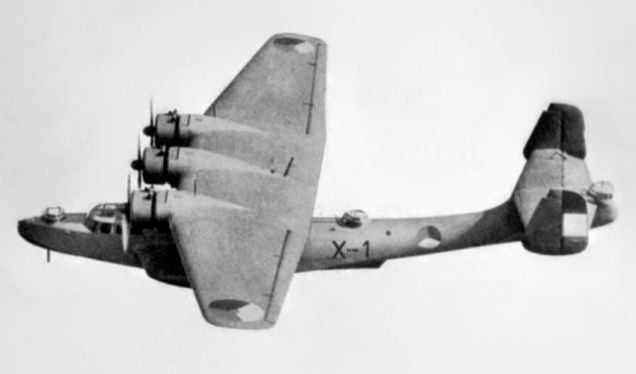
(UK Government)
July 3, 1937 – The first flight of the Dornier Do 24,
a three-engine German flying boat built by
!!!error: Indecipherable SUB-paragraph formatting!!!
for maritime patrol and search and rescue. Dornier developed the Do 24 to meet a requirement from the Dutch navy to replace the
!!!error: Indecipherable SUB-paragraph formatting!!!
(Whale) that had been introduced in the same role in 1923 for service in the Dutch East Indies. The all-metal,
!!!error: Indecipherable SUB-paragraph formatting!!!
Do 24 entered service in November 1937 and, according to Dornier records, the large flying boat was credited with as many as 12,000 rescues during its time in service. It was also used used as a maritime attack aircraft, and was responsible for the sinking of the Japanese destroyer
!!!error: Indecipherable SUB-paragraph formatting!!!
on December 17, 1941. A total of 279 were produced between 1937-1945, and one remains airworthy today, with its radial engines replaced by modern turboprops.
!!! UNKNOWN CONTENT TYPE !!!
Connecting Flights
!!! UNKNOWN CONTENT TYPE !!!
!!! UNKNOWN CONTENT TYPE !!!
!!! UNKNOWN CONTENT TYPE !!!
!!! UNKNOWN CONTENT TYPE !!!
!!! UNKNOWN CONTENT TYPE !!!
If you enjoy these Aviation History posts, please let me know in the comments. And if you missed any of the past articles, you can find them all at
!!!error: Indecipherable SUB-paragraph formatting!!!
. You can also find more stories about aviation, aviators and airplane oddities at
!!!error: Indecipherable SUB-paragraph formatting!!!
.
!!! UNKNOWN CONTENT TYPE !!!
 Derpwagon
> ttyymmnn
Derpwagon
> ttyymmnn
07/03/2018 at 13:23 |
|
thanks!
 AfromanGTO
> ttyymmnn
AfromanGTO
> ttyymmnn
07/03/2018 at 13:26 |
|
You know I was going to ask this. Do you have a picture of the last Dornie r Do 24? Is it being used for tourism or is it in a museum?
 Hamtractor
> ttyymmnn
Hamtractor
> ttyymmnn
07/03/2018 at 14:09 |
|
Photos really don’t do any justice to the massive size of the C5 Galaxy. I caught a MAC flight from Kadena AFB to the States on emergency leave back in 1994, and it was like walking into a hangar...
 Mondial goes to 11
> AfromanGTO
Mondial goes to 11
> AfromanGTO
07/03/2018 at 14:36 |
|
It seems Foxtrot Alpha covered the plane a bit a few years ago. The plane’s Facebook page is active although the actual plane’s homepage is not. I believe it’s still airworthy as it’s scheduled to appear at the Dornier museum in August .
 ttyymmnn
> AfromanGTO
ttyymmnn
> AfromanGTO
07/03/2018 at 15:15 |
|
Looks like Mondial covered it. I’ve got a few pictures o f the D0 24 in my screensaver rotation. I love it. It looks like a water bug.
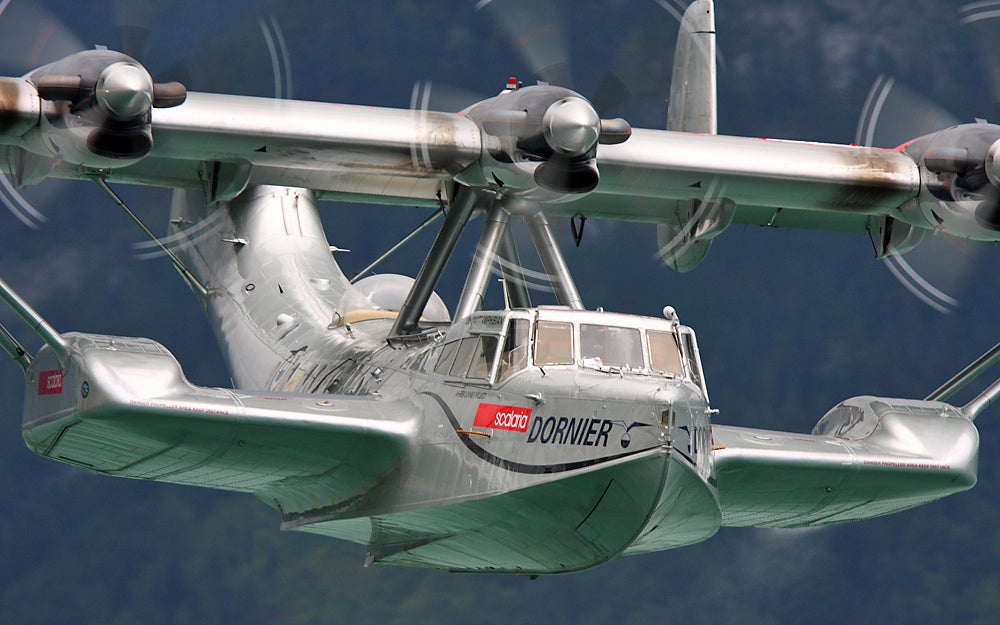
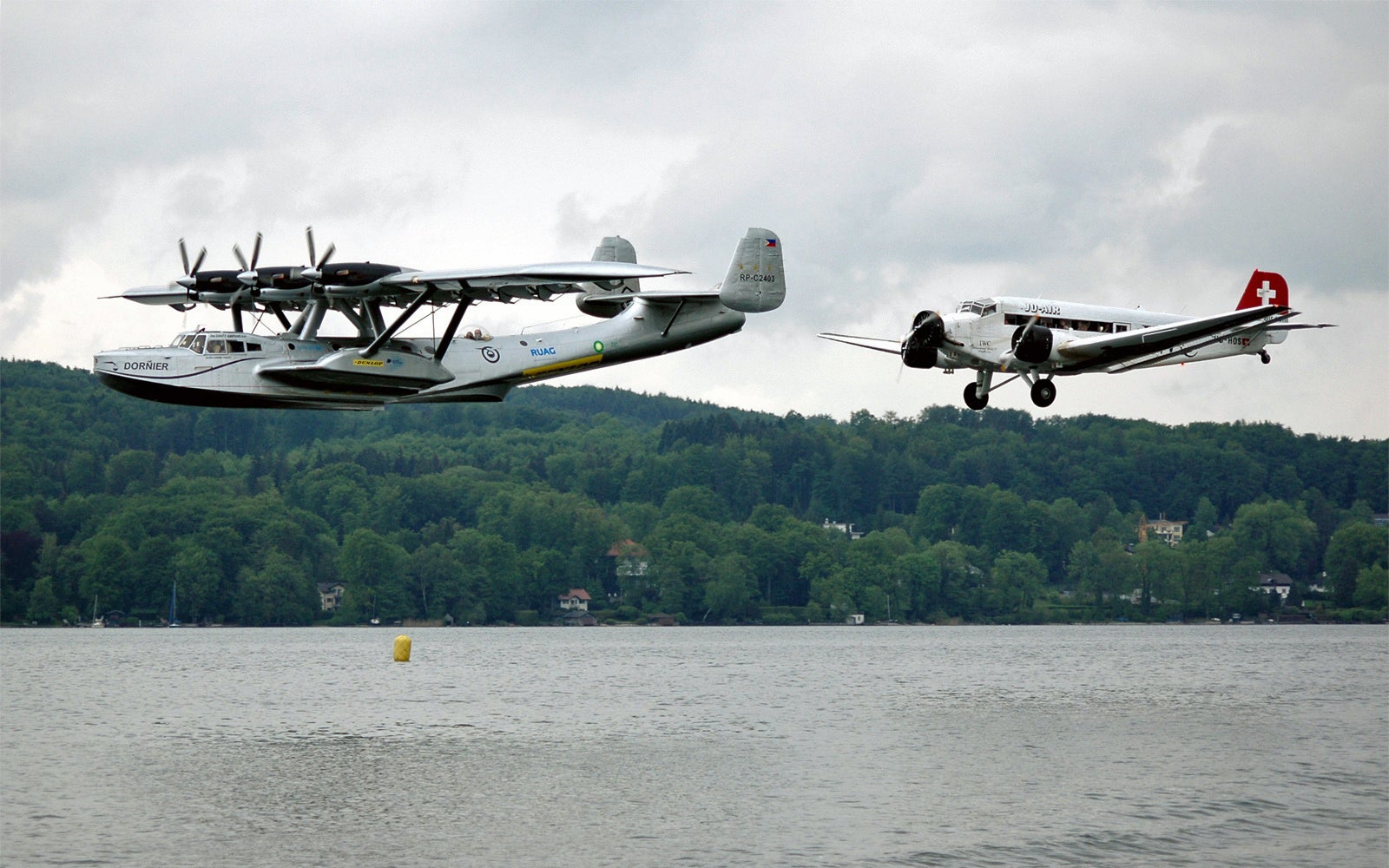
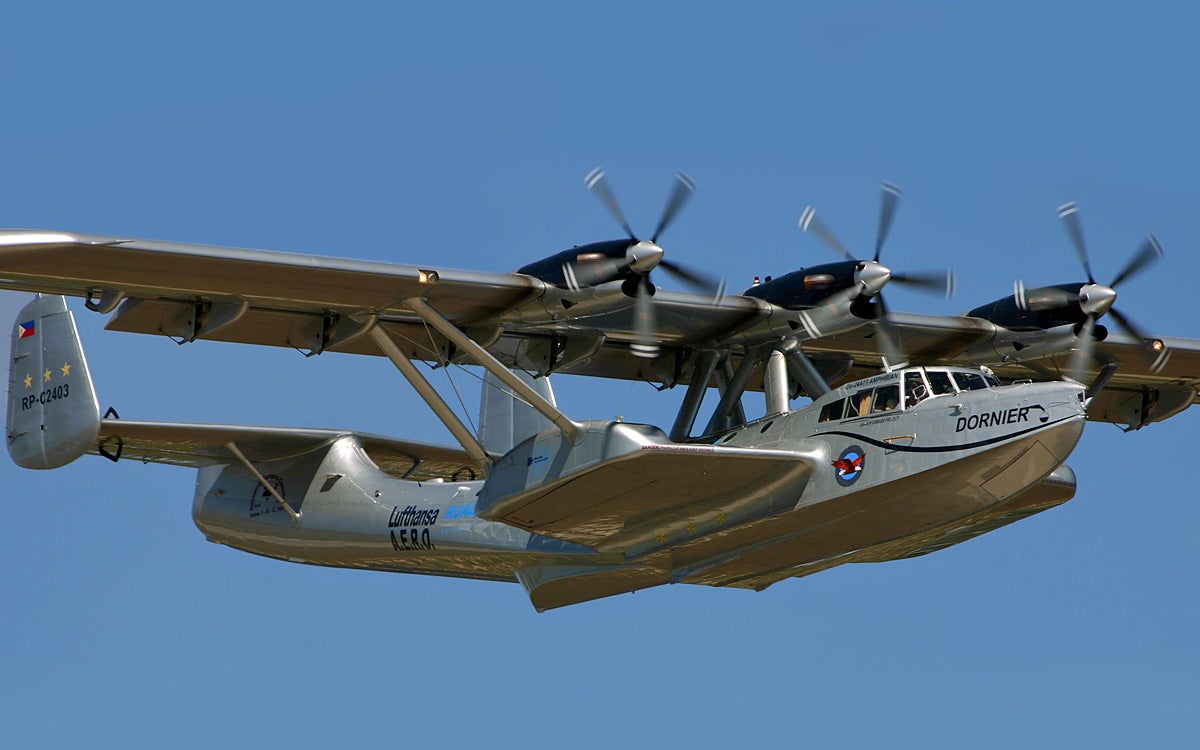
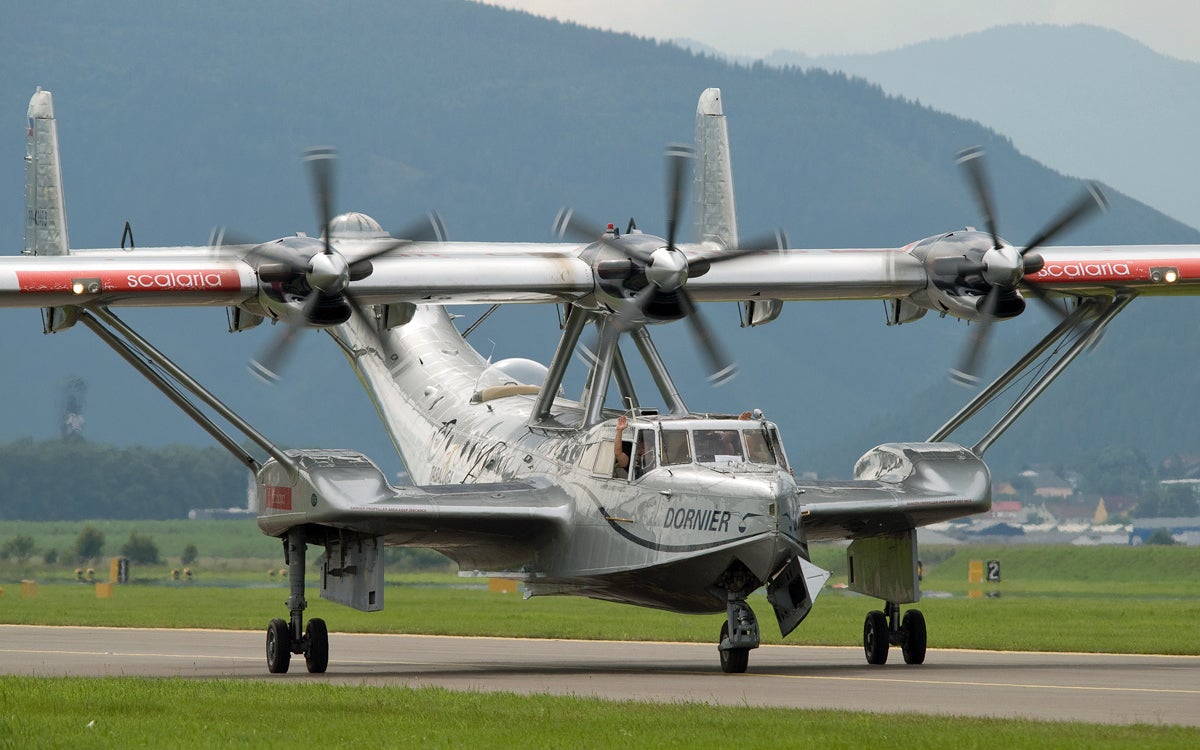
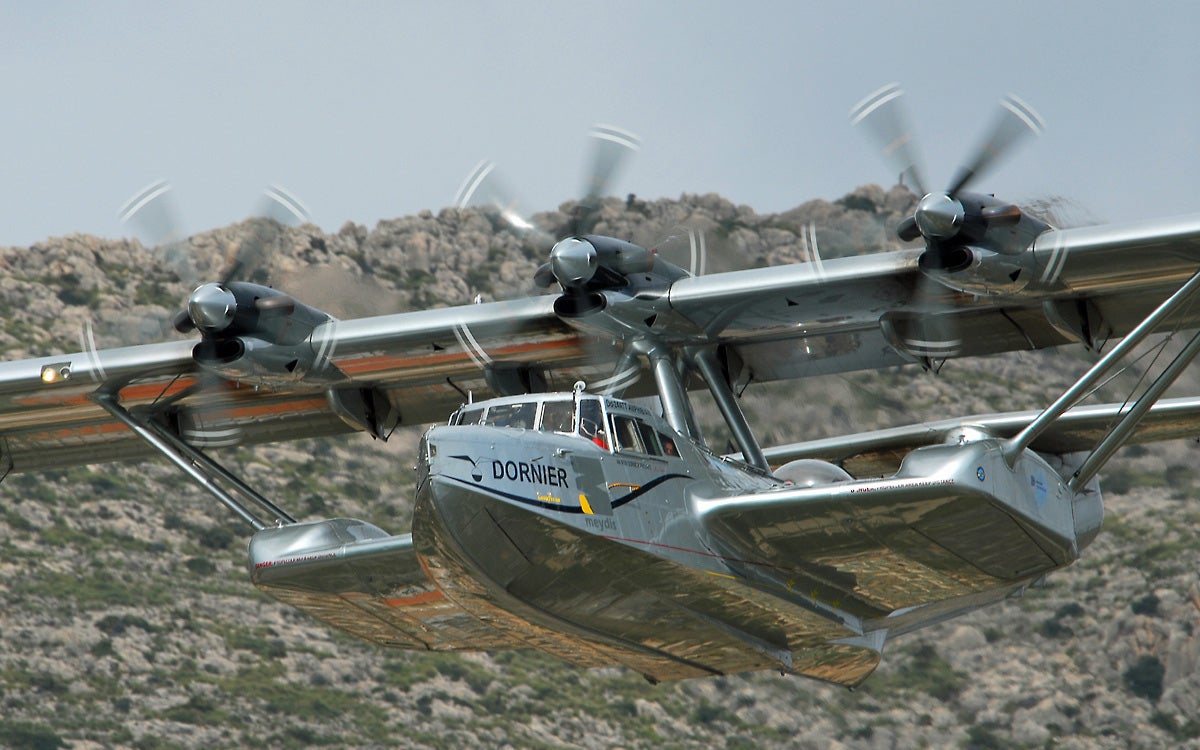
 ttyymmnn
> Hamtractor
ttyymmnn
> Hamtractor
07/03/2018 at 15:16 |
|
My brother was un the Army back in the 80s. He recalls guys playing frisbee inside one while in flight.
 Manwich - now Keto-Friendly
> ttyymmnn
Manwich - now Keto-Friendly
> ttyymmnn
07/03/2018 at 15:16 |
|
“ Blériot XI monoplane suddenly pitched forward, ejecting both her and her passenger at an altitude of 1,500 feet. Ironically, the plane came to earth relatively undamaged.”
I’m trying to wrap my head around how that’s even possible.
 ttyymmnn
> Manwich - now Keto-Friendly
ttyymmnn
> Manwich - now Keto-Friendly
07/03/2018 at 15:20 |
|
No seat belts, open cockpit, no top wing. And shitty luck.
 Manwich - now Keto-Friendly
> ttyymmnn
Manwich - now Keto-Friendly
> ttyymmnn
07/03/2018 at 15:27 |
|
Okay but I would think that if the plane pitches forward and they go flying out, then wouldn’t the plane also be heading for a crash landing instead of landing relatively undamaged
?
 ttyymmnn
> Manwich - now Keto-Friendly
ttyymmnn
> Manwich - now Keto-Friendly
07/03/2018 at 15:30 |
|
At 1,500 feet I could see how it would have plenty of time to level out on its own. As far as what “pitched forward” really means, it’s hard to say. That description of events was written over 100 years ago, likely by people who had no inkling of what it meant to fly a plane.
 merged-5876237249235911857-hrw8uc
> ttyymmnn
merged-5876237249235911857-hrw8uc
> ttyymmnn
07/03/2018 at 18:51 |
|
I thought they were retiring the C-5 in favor of the C-17? Those C-5s are massive. They used to do laps over WPAFB when I was down there back in ‘08-‘12
 AfromanGTO
> Mondial goes to 11
AfromanGTO
> Mondial goes to 11
07/03/2018 at 18:53 |
|
That’s awesome! Hopefully one day it’ll make it over to the states, so I can see it in person.
 AfromanGTO
> ttyymmnn
AfromanGTO
> ttyymmnn
07/03/2018 at 18:54 |
|
I’d love to fly around in that! It looks so cool!
 ttyymmnn
> merged-5876237249235911857-hrw8uc
ttyymmnn
> merged-5876237249235911857-hrw8uc
07/03/2018 at 18:54 |
|
There was talk of defunding the program, but that got reversed. The C-5 can carry a lot more ass and trash than the C-17. It also flies about twice as far.
 merged-5876237249235911857-hrw8uc
> ttyymmnn
merged-5876237249235911857-hrw8uc
> ttyymmnn
07/03/2018 at 20:46 |
|
That’s a good deal. They had just added a hanger or two at Wright Patt a few years before I heard they were replacing them, seemed like such a waste. Good to know they’re carrying on.